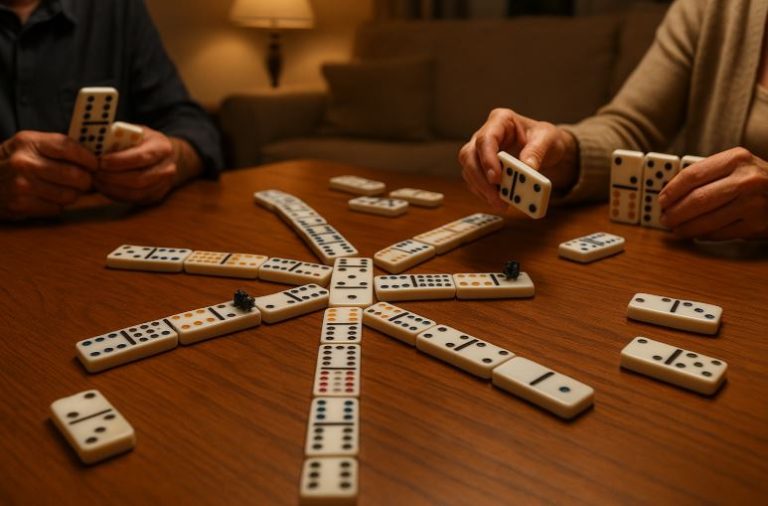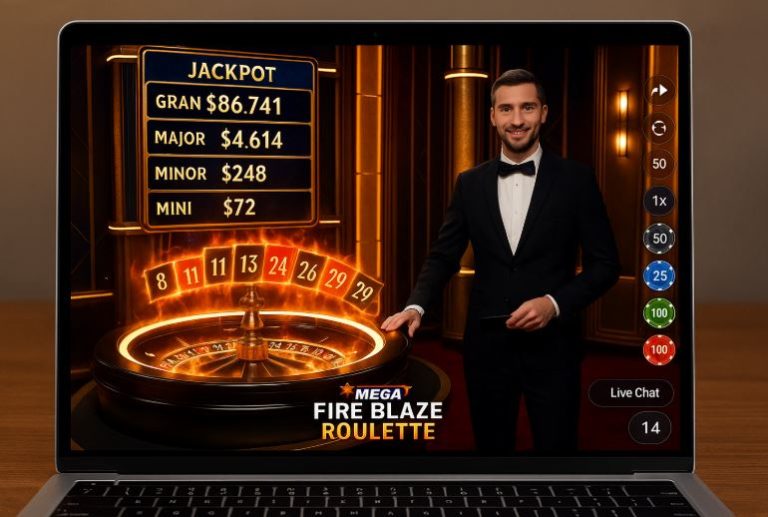Can You Really Cheat a Casino Slot Machine? | The Myths, Truths, and Tech Behind the Reels
Slot machines are among the most enticing and profitable games on the casino floor — not just for players and casinos, but historically, also for cheaters.
Over the years, some have attempted to outsmart the system, drawn in by the prospect of massive payouts. However, with the rise of digital technology and stringent regulation, cheating has become nearly impossible and far more costly than it’s worth.
In this comprehensive guide, we’ll uncover how slot machines work, the most infamous cheating methods from history, and why modern-day security means there’s no winning against the house through dishonest means.
How Do Slot Machines Really Work in UK Casinos?
Understanding the fundamentals of slot machines can help dispel many myths about cheating.
The Role of RNG (Random Number Generator)
All legitimate slot machines, whether online or physical, use Random Number Generator (RNG) software. These are sophisticated algorithms that produce unpredictable results to guarantee fair gameplay.
- RNGs are continuously active, even when the machine isn’t in use.
- Each spin is independent of the last, making patterns impossible to track.
- Machines are audited regularly by the UK Gambling Commission to ensure fairness.
Understanding the Slot Machine Algorithm and House Edge
The house edge is built into each game through an algorithm that defines the Return to Player (RTP). A machine with a 95% RTP will, over time, return £95 of every £100 staked, keeping £5 for the house.
Slot Machine Cheating Techniques From the Past
1. Cheat Code Engineer – Ronald Dale Harris and the Insider Code Scam

Perhaps the most shocking cheating case in casino history is that of Ronald Dale Harris, a computer programmer who worked for the Nevada Gaming Control Board.
His role was to test and verify slot machines for fairness and security. Ironically, Harris used this position of trust to orchestrate one of the most significant cheating operations ever uncovered.
How it worked:
- Harris discovered a way to manipulate the random number generators (RNGs) by inserting secret cheat codes into the slot software.
- These codes could be triggered by a specific sequence of inputs, such as a timed button press or coin insert pattern.
- Once activated, the machine would guarantee a jackpot, often within a few spins.
Harris used his insider knowledge to identify which machines he had altered, then recruited accomplices to play them.
One of the most notable events occurred in 1995 when his associate hit a £80,000 ($100,000) jackpot on a Keno machine at Bally’s Casino in Las Vegas, a win so statistically improbable that it raised red flags and triggered an investigation.
Outcome:
Harris was eventually arrested and sentenced. His case highlighted a major flaw in gaming software oversight and triggered widespread reforms in machine certification and regulatory control.
Lesson: Insider access can be as dangerous as external manipulation. The Harris case led to tighter governance of slot software development and audits.
2. Shaved Coins – Exploiting Early Optical Sensors
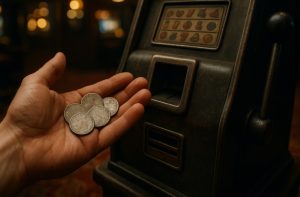
The shaved coin technique is a classic example of early physical slot machine fraud. It took advantage of the limitations of optical coin sensors, which were introduced to replace mechanical comparators.
How it worked:
- The scam involved shaving the edges of a genuine coin to slightly reduce its size and weight.
- The cheater would then insert a foreign object (often a washer or slug) into the machine simultaneously.
- The optical sensor would read the coin-like shape of the washer and allow play, while the shaved coin would be returned to the user’s hand or fall into a retrieval tray.
This method allowed players to continuously play without actually spending money, effectively giving them unlimited turns until they won.
Why it eventually failed:
- Newer machines use multi-factor coin validation, including magnetic signatures, weight sensors, and size verification.
- Advanced machines even scan the metal composition of coins and tokens, making shaved or fake coins instantly detectable.
Fun fact: Casinos eventually installed cameras aimed directly at coin slots to catch suspicious movements like dual coin insertion or quick retrieval actions.
3. Fake Coins – Louis “The Coin” Colavecchio’s Counterfeit Empire
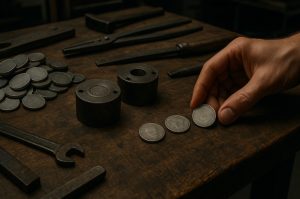
Louis Colavecchio, infamously nicknamed “The Coin,” was a master counterfeiter who used his engineering expertise to produce near-perfect fake slot machine tokens. He targeted casinos that still used physical coin mechanisms and became one of the most prolific slot cheaters of all time.
How it worked:
- Using precision moulds and high-quality metal, Colavecchio created counterfeit tokens that mimicked the size, weight, design, and even the magnetic properties of real tokens.
- He distributed thousands of these tokens across various Atlantic City and Las Vegas casinos, inserting them into machines and cashing out real payouts.
- At one point, he had so many fake tokens in circulation that casinos couldn’t tell which were real.
How he was caught:
In 1998, the Secret Service and FBI began investigating after slot machines at multiple casinos were being overfilled with tokens, far more than were ever issued. Colavecchio was eventually apprehended with sacks of fake tokens and presses used to manufacture them.
He was imprisoned, released in 2006, and shockingly re-offended just months later by printing counterfeit currency and tokens again.
Quote from authorities: “He was so skilled, the tokens were better than the real ones.”
4. Magnet Trick – Manipulating Mechanical Reels
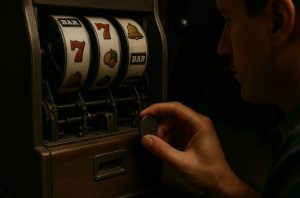
Before digital slot machines became the standard, most machines were mechanical with physical reels. These machines were vulnerable to an old-school but clever trick: using magnets to stop the reels manually.
How it worked:
- The cheater would spin the reels, just like a normal game.
- As the reels spun, they would hold a strong magnet against the side of the machine.
- When their desired symbols lined up on the payline, they would remove the magnet, allowing the reels to stop in the “winning” position.
- The machine would register the win as legitimate and trigger the payout.
This method required timing and precision, but it was remarkably effective on older models that had no internal shielding or sensor-based security.
How it was stopped:
- Manufacturers began installing metal shielding and non-magnetic components inside the reels.
- Modern slot machines are fully digital and no longer use physical reels, making magnets completely ineffective.
Historical note: This method was so widespread in the 1960s and 70s that many casinos began issuing handheld metal detectors to security staff.
5. Yo-Yo Coin Trick – The Original Coin-On-A-String Scam
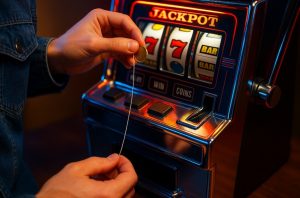
One of the most iconic and simplistic cheats, the yo-yo coin trick, dates back to the earliest electromechanical slot machines and even some older arcade-style games.
How it worked:
- The player would attach a string or wire to a coin.
- The coin was lowered into the machine until it triggered the game to start.
- Before the machine could capture the coin, the player would pull the coin back out, retrieving it for repeated use.
This cheat effectively allowed infinite free plays, giving the player unlimited chances to win without paying.
Why it worked:
- Early machines only required a brief signal from the coin comparator to activate a game.
- They did not have mechanisms to lock coins inside or to verify whether a coin remained in the machine.
Why it no longer works:
- Modern machines have one-way entry points, secure coin catchers, and internal blocking sensors that detect any string-like interference.
- Coin slots now include light sensors and timed drop checks that make this trick impossible.
Did you know? Many casinos would manually check coin chutes for fine scratches, often a sign that a coin-and-string trick had been attempted.
6. Top-Bottom Joint – The Tool That Brought Down Machines
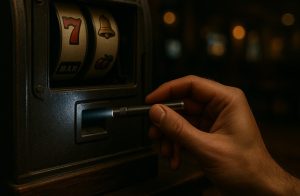
The Top-Bottom Joint was a specially crafted cheating device popular in the 1970s and 1980s. It was used to manipulate the machine’s coin validation mechanism directly.
Structure of the device:
- Top: A short, curved metal rod that resembled the letter “Q”
- Bottom: A long, stiff wire that could be inserted through the machine’s coin return mechanism
How it worked:
- The “bottom” wire was inserted into the coin return slot.
- The “top” rod was placed into the coin insert slot.
- When both tools were inside the machine, they could be used to apply force or electrical contact to trip internal sensors or mechanical arms.
- This would bypass the payout logic, essentially telling the machine that a large win had occurred — even if it hadn’t.
The Top-Bottom Joint was one of the first devices that required a mechanical understanding of how slots operated, moving away from basic trickery to actual machine interference.
Why it was dangerous:
- It often damaged the machines, which made it easier for casino staff to detect tampering.
- It required the cheater to work quickly and precisely to avoid detection by staff or surveillance.
Fun fact: The Top-Bottom Joint was so prevalent that some casinos displayed confiscated examples at the entrance of their security rooms as a warning.
7. Monkey Paw – Carmichael’s Ingenious Wire Contraption

The Monkey Paw is one of the most legendary and simplistic cheating devices ever created — and it came from the mind of Tommy Glenn Carmichael, a name synonymous with slot machine scams in the 1980s and 1990s.
Carmichael, a former TV repairman, used his technical know-how to create and test tools that manipulated slot machine internals. Among his inventions, the Monkey Paw stood out for its effectiveness and simplicity.
How it worked:
- Carmichael fashioned the Monkey Paw using a sturdy guitar string attached to a bent metal rod.
- The device was inserted through the air vent or payout chute of the slot machine.
- Once inside, the wire was jiggled or maneuvered to trigger the internal coin hopper switch.
- This tricked the machine into thinking a legitimate win had occurred, initiating a payout.
What made it brilliant was its design — small enough to conceal, easy to use quickly, and functional on a wide range of mechanical slot machines.
Why it worked:
- Older machines lacked internal shielding and had exposed mechanical components that were vulnerable to interference.
- The coin hopper switch had no security layers beyond basic physical contact, making it an easy target for anyone who could access it.
The impact:
Carmichael used this method (and later, more advanced ones) to steal millions of pounds in winnings over a 20-year career. His exploits forced the industry to revolutionise slot machine security and influenced the eventual elimination of mechanical payout systems.
Did you know? Carmichael later became an advocate for slot machine security and helped design anti-cheating technologies after his release from prison.
8. Bill Validator Device – The Optical Illusion Cheat

The bill validator device was a small, clever tool that allowed cheaters to fool slot machines into accepting low-value banknotes as high-value ones. It was often used during the late 1990s and early 2000s, before bill validators became highly sophisticated.
How it worked:
- Cheaters would wrap a thin, magnetic strip or foil around a £1 or £5 note.
- This altered the optical and magnetic properties of the bill to resemble a higher denomination, such as £100.
- When inserted into the machine’s bill acceptor, the sensor would misread the value and credit the cheater far more than what they had actually deposited.
- The player could then play higher-stakes games or cash out the balance.
Why it worked:
- Early bill validators relied on simple magnetic ink recognition, and their sensors were vulnerable to manipulation.
- The machine was unable to verify watermarks, holograms, or ink composition at the time.
Countermeasures introduced:
- Modern machines use multi-spectral imaging, ultraviolet scanners, and high-speed processors that detect even the slightest deviation from authentic currency.
- They also log bill serial numbers and alert staff to repeated high-denomination notes from a single user.
Real-world case: Multiple casinos in Atlantic City reported losses from this trick in 2001–2003, leading to significant upgrades in their bill validation hardware.
9. Chip Replacement – The High-Tech Inside Job

Replacing a slot machine’s internal computer chip is arguably one of the most technical and damaging methods of cheating. It requires specialist knowledge, access to the machine, and the ability to manufacture or program a fake chip.
The most well-known figure associated with this technique was Dennis Nikrasch, a former locksmith who orchestrated one of the largest casino scams in US history, and possibly the world.
How it worked:
- Nikrasch purchased slot machines from suppliers or second-hand dealers to study their internal architecture.
- He identified the specific EPROM chips that controlled win outcomes and programmed custom chips with payout triggers.
- Nikrasch used forged casino keys and a team of operatives to gain access to real machines on casino floors.
- They would swap out the original chip with the fake, play a few rounds, and trigger a guaranteed jackpot payout.
The team was so fast and skilled that a chip could be swapped in less than 60 seconds. They targeted high-stakes machines with payouts exceeding £250,000.
Why it worked:
- Casinos had no real-time monitoring of internal chip changes at the time.
- Machines didn’t alert the central server when tampering occurred.
- Chip serial numbers were rarely verified unless an issue was reported.
How it ended:
Nikrasch was eventually caught in the mid-2000s after casino surveillance footage linked a suspicious group of winners to multiple locations. Authorities discovered his storage unit, filled with reprogrammed chips, tools, and schematics.
Estimates suggest his team stole over £10 million across dozens of casinos.
Casino industry response:
- Machines are now equipped with tamper-evident security seals.
- Internal components trigger automatic alerts if disturbed.
- Chip replacements must be logged, timestamped, and verified by casino tech teams.
Security note: Today’s slot machines store code in non-removable memory (ROM) chips or secure flash drives protected by encryption, rendering this cheat obsolete.
10. Software Glitches – Exploiting the Code Behind the Reels

One of the more modern slot machine cheating methods doesn’t involve physical tools at all. Instead, it relies on manipulating software vulnerabilities, also known as glitch exploitation. This method typically doesn’t involve altering the machine, but instead takes advantage of bugs or flaws in its programming.
How it worked:
- Players discovered that performing a specific sequence of actions, such as placing bets in a certain pattern or switching game modes repeatedly, would confuse the game logic.
- In some instances, this would cause the machine to trigger a large payout, even though no true win had occurred.
- These glitches were often the result of coding errors, especially in early digital or hybrid slot machines.
Famous real-world case:
In 2011, Pauline McKee, a 90-year-old grandmother from Illinois, believed she had won £32 million on a “Miss Kitty” penny slot at the Isle Casino Hotel. Unfortunately, the machine had glitched, and the casino refused to pay, citing a “bonus malfunction.” Courts upheld the casino’s defence, and McKee received only £2.15, the actual win value.
Other examples: Skilled players in the 2000s discovered a flaw in IGT slot machines that, when combined with a rapid double-bet, would generate payouts exceeding standard limits. IGT later patched the software after multiple claims.
Why it’s virtually impossible today:
- Slot games undergo multiple rounds of software audits by independent bodies like eCOGRA and GLI before release.
- Developers use error-handling scripts that nullify unusual behaviour and roll back the game if anomalies are detected.
- Casinos monitor suspicious payout patterns and flag potential software issues automatically.
Quick Tip: If a payout feels too good to be true, especially from a low-stakes game, casinos will check the system logs, and any winnings may be voided if a software fault is proven.
11. Coat Hanger Trick – Hooking the Payout Mechanism

Crude, but once effective, the coat hanger trick was one of the earliest mechanical cheats used to access and manipulate slot machine internals, especially coin payout arms and reels.
How it worked:
- Cheaters would reshape a wire coat hanger into a hook or loop, stiff enough to hold shape but flexible enough to bend around internal components.
- They would insert it through the coin return chute or payout slot and carefully manoeuvre it until they reached the coin release mechanism.
- A quick tug or twist could then trigger the payout, dispensing coins as though a real win had occurred.
Why it worked:
- Older machines had minimal shielding, and their physical components were easily reachable through open vents or wide coin slots.
- The coin mechanism worked on a mechanical arm and trigger, meaning it could be activated with manual force.
Why it failed:
- By the late 1990s, most machines were built with anti-tamper plates, internal guards, and sealed coin channels that prevented any foreign object access.
- Machines were updated to detect foreign objects inside chutes and lock up immediately.
Did you know? Some casinos even fitted metal mesh filters inside payout slots to prevent wire-based tools from being inserted.
12. RNG Hacking – Trying to Predict the Unpredictable

RNG (Random Number Generator) hacking is considered the holy grail of slot machine cheating. If a player could somehow predict the RNG sequence, they could, in theory, forecast winning combinations and place bets accordingly.
While highly theoretical in modern casinos, there were real-world attempts to crack this system, especially during the transition from mechanical to fully digital slots.
How it worked:
- Some older machines used predictable pseudo-random number generators (PRNGs).
- A PRNG starts with a “seed” value and then uses formulas to generate subsequent numbers. If a hacker could figure out the seed, they could calculate when a jackpot symbol was due to appear.
- Some developers created RNG cracker apps that attempted to reverse-engineer outcomes based on game logs and outcomes.
Real incident:
In the early 2000s, a group of Russian hackers allegedly cracked the PRNG system of certain Aristocrat slots.
They used reverse engineering and hidden cameras to record gameplay, then fed the footage into software that predicted future spins.
They would send instructions to an accomplice in the casino via mobile phone, telling them exactly when to press “Spin.”
They successfully hit multiple jackpots across Europe and the US, stealing millions before being caught.
Why it’s no longer feasible:
- Modern machines use true RNG systems or cryptographically secure PRNGs, making their outcomes nearly impossible to predict.
- RNGs now run on closed-loop circuits, which reset frequently and are inaccessible from outside the machine.
- Security teams now flag players who time their bets too precisely, using pattern recognition AI.
Quick fact: RNG systems today often use external entropy sources, like atmospheric noise or user input speed, to make them more secure and truly random.
16 Historic Slot Machine Cheating Techniques
| Technique Name | Description | Time Period |
| Cheat Code Engineer | Used insider code to trigger wins | 1990s |
| Shaved Coins | Bypassed coin sensors using shaved currency | 1980s |
| Fake Coins | Used counterfeit coins to activate machines | 1990s |
| Magnet | Used to stop mechanical reels at will | Pre-1980s |
| Yo-Yo Coin | Pulled coin back on string after activating game | Early 1900s |
| Light Wand | Blinded coin sensor to force payouts | 1980s–1990s |
| Piano Wire | Jammed rotation counters to manipulate spins | 1982 (documented) |
| Top-Bottom Joint | Inserted to trip internal payout mechanism | 1970s–1980s |
| Monkey Paw | Activated payout switch from air vent | 1990s |
| Bill Validator Tool | Tricked machine into accepting lower value notes | Late 1990s |
| Computer Chip Replacement | Reprogrammed payout chip to release jackpots | 1990s–2000s |
| Software Glitch Exploit | Triggered errors to cause inflated jackpots | Ongoing |
| Coat Hanger | Hooked internal parts to mislead mechanics | Pre-digital era |
| Hacking RNG Cycles | Predicted machine outcomes through RNG patterns | Theoretical |
| Programming the Machine | Adjusted game software to alter outcomes | Rare, insider only |
| Blunt Force | Physically struck machine to interrupt function | Myth/old machines |
Can You Cheat Online Casino Slot Machines?
With the rise of digital gambling, many wonder: can online slot machines be cheated? The short answer is no.
Why You Can’t Cheat Online Slots?
- RNGs (Random Number Generators) are used in every game to guarantee unpredictable results.
- All UK-licensed online casinos are regulated by the Gambling Commission.
- Any attempt to hack or tamper with games is immediately detected and flagged.
What You Can Do Instead?
While cheating is illegal and impossible, you can still improve your gameplay by using legitimate strategies:
- Focus on high RTP games (above 96%).
- Make use of welcome bonuses and free spins.
- Specialise in one or two games rather than many.
How Casinos Catch Slot Machine Cheaters?
Surveillance and AI Monitoring
Casinos use HD surveillance cameras, facial recognition software, and Casino Anti-Cheating and Recognition Systems (CARDS) to detect cheaters. Suspicious behaviour is monitored in real-time.
Routine Machine Audits
Machines are inspected regularly for tampering, and digital logs track every spin, coin inserted, and payout made.
What Defines Cheating in Slot Machines?
Cheating can include:
- Using tools to manipulate machines
- Replacing internal components
- Exploiting software vulnerabilities
- Attempting digital hacks on RNG
Warning: Cheating is a criminal offence in the UK under the Gambling Act 2005, punishable by fines, imprisonment, and lifetime bans from casinos.
How to Protect Yourself from Casino Cheats?
Check for a Casino’s Licence
Always ensure the casino you play at is licensed by authorities like:
- UK Gambling Commission
- Malta Gaming Authority (MGA)
- Gibraltar Regulatory Authority
- Kahnawake Gaming Commission
Evaluate Payout Rates
Check RTP (Return to Player) percentages before choosing a game. Games with higher RTPs offer better long-term chances.
Read Verified Online Reviews
Use platforms with real player feedback and avoid casinos with suspicious or overwhelmingly negative comments.
Conclusion
Cheating may once have been part of gambling folklore, but today’s slot machines are tamper-proof and fully secure. With complex software, strict regulation, and high-tech surveillance, the days of tricking a slot machine are long gone.
Rather than looking for cheats, focus on understanding the game, setting responsible limits, and choosing fair, regulated casinos.
Frequently Asked Questions
Are these cheating techniques still used today?
No. Modern machines are fully digital, encrypted, and protected against these types of manipulation.
What’s the punishment for cheating at slots in the UK?
Legal consequences can include large fines, imprisonment, and permanent bans from casinos.
Is it legal to use software glitches to win?
No. Exploiting software errors is considered a form of fraud and is treated as such.
Can online slots be hacked?
No. Licensed online casinos use advanced encryption and RNGs that are virtually impossible to crack.
How can I increase my odds of winning slots legally?
Look for high RTP slots, use welcome bonuses, and manage your bankroll wisely.
Are RNGs truly random?
RNGs are pseudorandom but function in a way that makes them impossible to predict without illegal access.
How can I tell if a slot machine is fair?
Only play at casinos licensed by the UK Gambling Commission or another recognised authority.
Disclaimer
This content is for informational purposes only. We do not promote gambling, cheating, or illegal activities. Always gamble responsibly and within the law.



